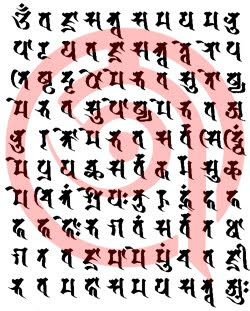Manuscript of Early Vajrasattva Mantra
This is a page from the Sarvatathāgata-tattvasaṅgraha (STTS), a 7th century Buddhist text concerning Tantric rituals. The STTS is classed as a Yoga Tantra by Tibetan Buddhists. Here we have the verso of the 15th palm leaf in the mantra containing what became the Hundred Syllable Vajrasattva Mantra. This is the oldest occurrence of the Vajrasattva Mantra (as far as the Chinese Canon is concerned).
This image is modified from the facsimile edition of a 10th century Nepalese palm-leaf manuscript using the Siddhaṃ script, published by Candra and Snellgrove. You will note that the Siddhaṃ script is significantly different from contemporary Siddhaṃ calligraphy (and much more difficult to read!)
If you want to have a go at reading it - note that you read from left to right right across the leaf (i.e. ignore the columns). The transliteration shows subtle differences from the well known 100 syllable mantra.
See the text inverted as well - this sometimes improves readability
This image is modified from the facsimile edition of a 10th century Nepalese palm-leaf manuscript using the Siddhaṃ script, published by Candra and Snellgrove. You will note that the Siddhaṃ script is significantly different from contemporary Siddhaṃ calligraphy (and much more difficult to read!)
If you want to have a go at reading it - note that you read from left to right right across the leaf (i.e. ignore the columns). The transliteration shows subtle differences from the well known 100 syllable mantra.
oṁ vajra sattvasamayamanupālaya vajrasattvatvenopatiṣṭha dṛḍho me bhava sutoṣyo me bhavānurakto me bhava supoṣyo me bhava sarvasiddhiñca me prayaccha sarvakarmasu ca me cittaśreyaḥ kuru hūṁ ha ha ha ha hoḥ bhagavan sarvatathāgatavajra mā me muṁca vajrībhava mahāsamayasatva āḥ||To see where the mantra is look at the version with the mantra highlihghted
See the text inverted as well - this sometimes improves readability
Labels: Manuscript, Siddham, Vajrasattva






